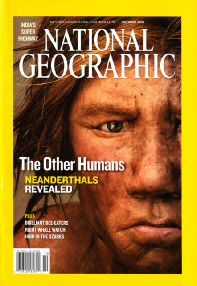

There's no way to sugar coat it: Obesity is a global problem. Once found largely in industrialized places, the condition is now on the rise in developing nations too–and sweet beverages are partly to blame.
Taxing could help curb the trend. In recent years at least ten countries have introduced surcharges on sugary drinks in an effort to reduce consumption. The U.K. is considering a tax; on the Pacific
island of Nauru, where most people are overweight, both sodas and flavoured milks are taxed.
Oliver Mytton, who studies public health at Oxford, says markets are feeling the impact. In France, for instance, fewer sweet drinks have been sold since a 2012 tax was implemented. What isn't clear yet is how much the levies are affecting waistlines. Still, says Mytton, they're "a step in the right direction."
Catherine Zuckerman
POPULATION
World Party: As the global population approaches the seven billion mark, we should all probably try to get to know one another a little better. What if somebody threw a party and invited every single person living on Earth? It would be a logistical nightmare, but you might be surprised at the relatively small size of the venue needed to fit seven billion people—even if we gave them enough room to dance.
Nigel Holmes
Elevators (lifts) and subway cars allow about two to three square feet of space per person.
But this is a party! Let's give everyone room to dance, say, six square feet.
That's 42 BILLION SQUARE FEETor 1,506.5 SQUARE MILES
HERE are some 1,500 square-
The city of Multan, Pakistan
Total land area of the 118 islands and atolls of French Polynesia
The emirate of Dubai
Juneau Icefield, Alaska
The state of Rhode Island (including parts covered by water, so some of us will need swimsuits)
AND...
if we just wanted to take a photo of seven billion people standing shoulder to shoulder, all we'd need is a place that's about 500 square miles. How about the city of Los Angeles?
If the photographer said "smile" in the 6,900-
IT CAME FROM OUTER SPACE
Is it possible to get hit by something falling from orbit? It's happened only once,
but NASA estimates that man-
Luna Shyr
Seasonal Flux
It's not only Earth that has a winter, spring, summer, and autumn. "Anything with an atmosphere has seasons," says NASA's Jim Green. They just look different on other celestial bodies.
Equinoxes and solstices mark the change in season and rotation, orbit, distance from the sun, and axial tilt all play a role in how weather shifts play out. When Pluto is farthest from the sun—winter—its atmosphere collapses. Saturn's rings don't cast shadows during equinoxes. On its moon Titan, spring showers are made of methane and can last for several Earth years. Winter, on Mars brings carbon dioxide snow. Mercury, notably, remains nearly seasonless—due to a thin atmosphere and a rotation so slow that one of its days is equal to the length of two of its years.
Johnna Rizzo
Losing Sleep
It was my first night in the Tanzanian bush, and I was near Ruaha, a region known for its abundance of lions. The camp owner welcomed me and said, "Your tent is over that way," indicating the thick bushes next to the river, past the tents on raised platforms. I came across a clearing on the river's edge. I paused to watch hippos meandering into the water and noticed a pup tent perched on what appeared to be the main hippo trail down to the water. This tiny structure was to be where I slept.
Not wanting to be dragged down by a lumbering hippo to drown in the river in a heap of multicoloured nylon, I moved my tent off the trail. I lay there listening to the bush sounds: nightjars and owls and screeching baboons and rushing water. Then I heard the unmistakable roar of a lion on the other side of the river. Then another—this time on my side. Then a third, deafening roar that split the night, followed by the crackle of nearby twigs as he stepped into the clearing and sniffed. I could smell him, so likely he could smell me too.
After circling, he stopped and stretched his body against the length of my tent, presumably to enjoy its warmth. As it buckled against him, I was pushed into the tiny space left against the opposite side—except for my left hand, which was under his bulk. After a few minutes he fell asleep. I didn't dare move my hand or risk startling him, so I lay there unmoving, trying to keep panic at bay.
I must have eventually fallen asleep in the aftermath of the adrenaline rush. The next thing I knew, sunlight was streaming in, and the tent was unbowed, with lion tracks in the sand outside. After that the pup tent was nicknamed the "death tent," and it was allocated a pitch on a raised platform
Amy Dickman Wildlife Biologist
Mouth Full
One in four people is a "supertaster," a label for those who have a higher number of taste buds, which results in a heightened sense of taste. The condition—seen more in women—can be bittersweet. Supertasters eat fewer leafy greens, elevating the risk of colon cancer. They're also averse to fats. What they all have in common, says University of Florida's Linda Bartoshuk, is they're picky eaters.
Dante Stone
29 Names, Same Plant
In 1753 Swedish naturalist Carl Linnaeus published Species Plantarum, a book describing some 6,000 plant species that became the foundation of modern plant nomenclature. The list of names has since ballooned to 1.05 million, but of those, only around 300,000 are now confirmed to be unique species. Nearly half a million others, it turns out, are redundant.
The scientific moniker for English oak has 314 synonyms, the common daisy 29, and the giant sequoia 18. Those are just a few identified so far in the Plant List, a working database created in 2010 by the Missouri Botanical Garden and London's Kew Gardens after years of vetting. "It's like people. We have different eye colours, shapes, and sizes, but we're all people," says botanist Bob Magill. "There's huge variation within a species."
Luna Shyr
Living It Up
Earth will soon be home to seven billion humans. If you find that hard to fathom,
try grasping how many have ever walked the planet. That's what American demographer
Carl Haub wanted to find out when, in 1975, he heard someone say that 75 percent
of the people who'd ever been born were alive at that time. Dubious, he set out to
disprove it, taking two main things into account: (1) the assumed dawn of humanity
and (2) average populations at different periods of time. Using 50,000 B.C. as his
starting point, Haub applied crude birthrates—the number of annual births per thousand
people—to each population set, then added them. His estimate? In 1975, 103 billion
people had lived, but only 4 percent of them were alive at that time. Applied to
2011, says Haub, those numbers are 108 billion, and 6.4 percent. Mind-
Catherine Zuckerman
